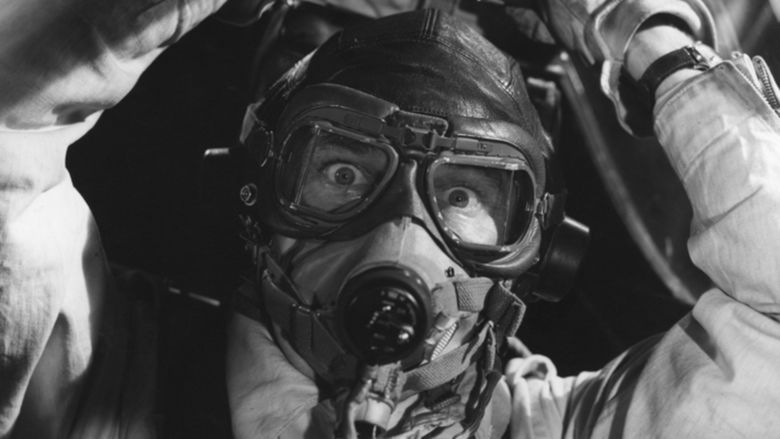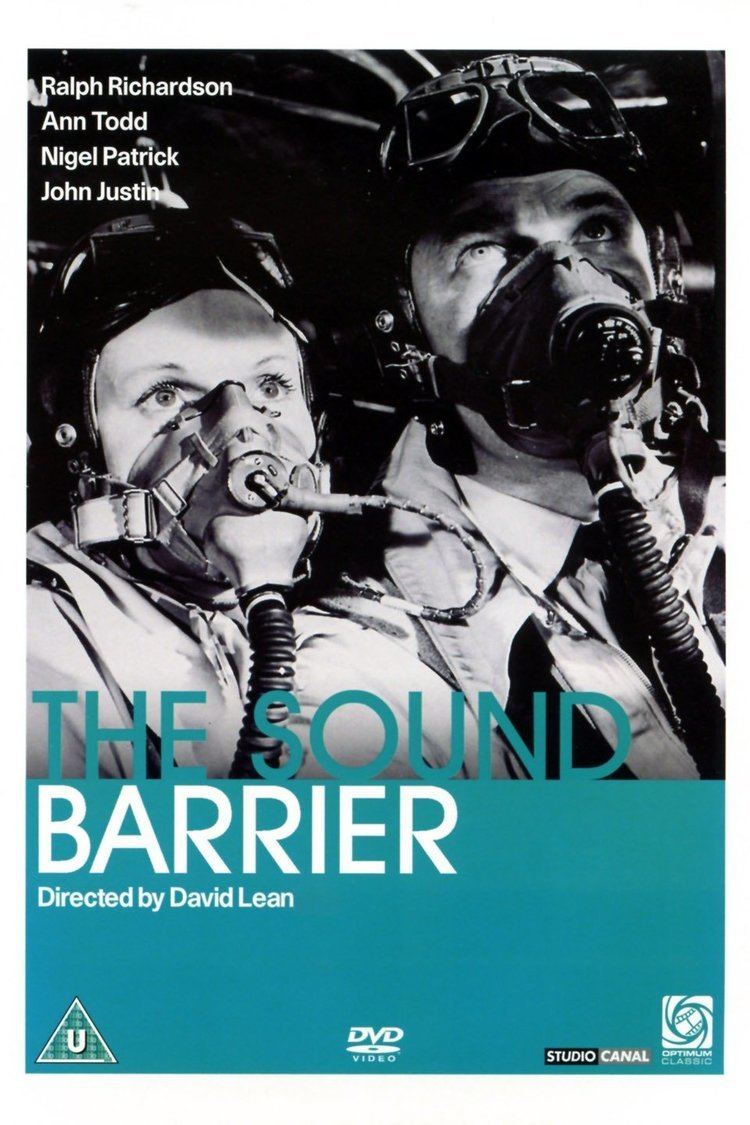The Sound Barrier
7 /10 1 Votes
Duration Country United Kingdom | 7/10 IMDb Genre Drama, Romance, War Language English | |||||||||||||||||||||||||||||||||
 | ||||||||||||||||||||||||||||||||||
Release date 22 July 1952 (1952-07-22) Cast (John Ridgefield), (Susan Garthwaite), (Tony Garthwaite), (Philip Peel), (Jess Peel), Similar movies Related David Lean movies | ||||||||||||||||||||||||||||||||||
Singin in the rain 3 8 movie clip the sound barrier 1952 hd
The Sound Barrier (known in the United States, as Breaking Through the Sound Barrier and Breaking the Sound Barrier) is a British 1952 film directed by David Lean. It is a fictional story about attempts by aircraft designers and test pilots to break the sound barrier. It was David Lean's third and final film with his wife Ann Todd, but it was his first for Alexander Korda's London Films following the break-up of Cineguild. The Sound Barrier stars Ralph Richardson, Ann Todd, and Nigel Patrick.
Contents
- Singin in the rain 3 8 movie clip the sound barrier 1952 hd
- Plot
- Cast
- Production
- Reception
- Academy Awards
- BAFTA Awards
- US National Board of Review
- New York Critics Circle
- References

The Sound Barrier was a box-office success on first release, but it has become one of the least-known of Lean's films. Following on In Which We Serve (1942), the film is another of Lean's ventures into a genre of filmmaking where impressions of documentary film are created.

Plot
After his aircraft company's groundbreaking work on jet engine technology in the Second World War, John Ridgefield (Ralph Richardson), its wealthy owner, employs test pilot Tony Garthwaite (Nigel Patrick), a successful wartime fighter pilot to fly new jet-powered aircraft. Garthwaite is hired by Ridgefield after marrying Ridgefield's daughter, Susan (Ann Todd). Tensions between father and daughter are accentuated by Garthwaite's dangerous job of test flying. In a noteworthy illustration of the new technology, Susan accompanies Garthwaite on a ferrying assignment of a two-seater de Havilland Vampire to Cairo, Egypt, returning later the same day as passengers on a de Havilland Comet.
Ridgefield's hopes for his new jet fighter, "Prometheus", has placed the company in jeopardy. The problems faced by the then-new jet aircraft in encountering the speed of sound, the so-called "sound barrier", are ever present. In an attempt to break the sound barrier, Garthwaite crashes and is killed. Shocked at the death of her husband and at her father's apparently single-minded and heartless approach to the dangers his test pilots face, Susan walks out on her father and goes to live with friends Jess (Dinah Sheridan) and Philip Peel (John Justin), another company test pilot. Ridgefield later engages Peel to take on the challenge of piloting "Prometheus" at speeds approaching the speed of sound. In a crucial flight, and at the critical moment, Peel performs a counterintuitive action (presaged in the opening scene of the film) which enables him to maintain control of the aircraft and to break the sound barrier.
Eventually accepting that her father did care about those whose lives were lost in tests, Susan changes her plan of moving to London and takes her young son with her back to live with Sir John.
Cast
(credits order)
Production
The strong relationship to aviation history in The Sound Barrier has led to its being characterised as a "semi-documentary". The film pays tribute to the British effort in the historic advance in aviation of the development and final perfecting of the jet engine by Frank Whittle and Power Jets Ltd and others following.
David Lean had begun to gather research based on media reports of jet aircraft approaching supersonic speeds, interviewing British aeronautic designers. He even managed to fly with test pilots as he produced a 300-page notebook that he turned over to dramatist Terence Rattigan. The subsequent screenplay concentrated on the newly discovered problems of flying at supersonic speeds and is also loosely based on the real-life story of aircraft designer Geoffrey de Havilland and the loss of his son. Geoffrey de Havilland, Jr. was the de Havilland company test pilot who died on 27 September 1946 attempting to fly faster than the speed of sound in the DH 108.
John Derry, another de Havilland test pilot, has been called "Britain's first supersonic pilot," because of a dive he made on 6 September 1948 in a DH 108.
Contrary to what is depicted in the film, the first aircraft to break the sound barrier was the rocket-powered Bell X-1 flown by Chuck Yeager of the United States Air Force in 1947. As Yeager, who was present at the U.S. premiere, described in his first biography, The Sound Barrier was entertaining, but not that realistic – and any pilot who attempted to break the sound barrier in the manner portrayed in the film (forcing the centre stick forward to pull out of a dive) would have been killed. Because the 1947 Bell X-1 flight had not been widely publicised, many who saw The Sound Barrier thought it was a true story, and that the first supersonic flight was made by a British pilot.
Studio filming was completed at Shepperton Studios, but the flying sequences were filmed at Chilbolton Aerodrome, Nether Wallop, Hampshire, under the direction of Anthony Squire. A Vickers Valetta and Avro Lancaster bomber served as camera platforms for the aerial sequences. With the assistance of the British Aircraft Constructors Association, aircraft featured in The Sound Barrier were loaned by Vickers, de Havilland and other British aerospace companies. In addition, footage of early 1950s British jet technology used in the film includes scenes of the de Havilland Comet, the world's first jet passenger airliner, the Supermarine Attacker and the de Havilland Vampire. A Supermarine Swift prototype (VV119) featured as the experimental Prometheus jet fighter. Not unlike its screen persona, the Swift was an aircraft design that underwent particularly difficult teething problems during development.
Malcolm Arnold (later knighted) composed the music score, for this, the first of his three films for David Lean. The others were Hobson's Choice (1954) and The Bridge on the River Kwai (1957).
Reception
The Sound Barrier, in its American title as Breaking the Sound Barrier was reviewed by Bosley Crowther in The New York Times. According to Crowther, "this picture, which was directed and produced in England by David Lean from an uncommonly literate and sensitive original script by Terence Rattigan, is a wonderfully beautiful and thrilling comprehension of the power of jet airplanes and of the minds and emotions of the people who are involved with these miraculous machines. And it is played with consummate revelation of subtle and profound characters by a cast headed by Ralph Richardson, Nigel Patrick, and Ann Todd".
Film historian Stephen Pendo further described the "brilliant aerial photography. ... Along with the conventional shot of the aircraft there is some unusual creative camera work. To illustrate the passage of a plane, Lean shows only the wheat in a field being bent by air currents produced by the unseen jet. ... Even the cockpit shots are very good, with the test pilots in G-suits and goggles framed by the plexiglass and sky backgrounds."
The Sound Barrier was the 12th most popular movie at the British box office in 1952, and also did well in the United States, making a comfortable profit. The film has been released on VHS, DVD and Blu-ray.
Academy Awards
With this film, Ralph Richardson became the first actor to win the New York Film Critics Award for Best Actor who did not also go on to win an Oscar nomination.
BAFTA Awards
US National Board of Review
New York Critics Circle
References
The Sound Barrier WikipediaThe Sound Barrier (film) IMDb The Sound Barrier themoviedb.org
